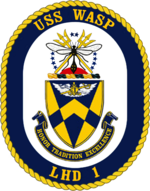 USS Wasp with MV-22 Osprey in the Gulf of Aqaba on 4 October 2007
| |
| History | |
|---|---|
| Name | Wasp |
| Namesake | USS Wasp (CV-18) |
| Awarded | 28 February 1984 |
| Builder | Ingalls Shipbuilding |
| Laid down | 30 May 1985 |
| Launched | 4 August 1987 |
| Commissioned | 29 July 1989 |
| Homeport | Norfolk |
| Identification |
|
| Motto | Honor, Tradition, Excellence |
| Nickname(s) | Building 1 |
| Status | in active service |
| Badge |  |
| General characteristics | |
| Type | Wasp-class amphibious assault ship |
| Displacement | 40,500 long tons (41,150 t) full load |
| Length | 846 ft (258 m) |
| Beam | 104 ft (31.8 m) |
| Draft | 27 ft (8.1 m) |
| Propulsion | Two boilers, two geared steam turbines, two shafts, 70,000 shp (52,000 kW); |
| Speed | 22 knots (41 km/h; 25 mph) |
| Range | 9,500 nautical miles (17,600 km; 10,900 mi) at 18 kn (33 km/h; 21 mph) |
| Well deck dimensions | 266-by-50-foot (81 by 15.2 m) by 28-foot (8.5 m) high |
| Boats & landing craft carried | |
| Troops | 1,687 troops (plus 184 surge) Marine Detachment |
| Complement | 66 officers, 1,004 enlisted[1] |
| Sensors and processing systems | |
| Armament |
|
| Aircraft carried |
|
USS Wasp (LHD-1) is a United States Navy multipurpose amphibious assault ship, and the lead ship of her class. She is the tenth USN vessel to bear the name since 1775, with the last two ships named Wasp being aircraft carriers. She was built by the Ingalls Shipbuilding division of Litton in Pascagoula, Mississippi. Wasp and her sister ships are the first specifically designed to accommodate new Landing Craft Air Cushion (LCAC) for fast troop movement over the beach, and Harrier II (AV-8B) Vertical/Short Take-Off and Landing (V/STOL) jets which provide close air support for the assault force. She can also accommodate the full range of Navy and Marine Corps helicopters, the tiltrotor MV-22 Osprey, the F-35B Lightning II multi-role fighter, conventional landing craft, and amphibious vehicles.[2]
- ^ "LHD-1 Wasp class". Federation of American Scientists. 9 May 2000. Archived from the original on 30 March 2013. Retrieved 8 April 2011.